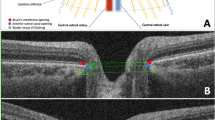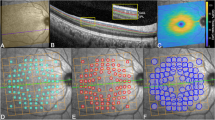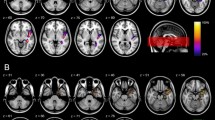Abstract
Purpose
To study the relationship between macular ganglion cell complex (GCC) thickness and visual field defects (VFD) caused by central nervous system (CNS) lesions in children and evaluate the possibility of predicting VFD according to GCC maps.
Methods
The GCC maps of a group of children with VFD due to CNS lesions with respect of the vertical meridian in at least one eye (study group), as well as of children with other neuro-ophthalmological problems and healthy children were presented to two masked evaluators, who were asked to predict the patients’ VFD on the basis of GCC damage: the evaluators classified VFD as normal, hemianopia (homonymous or heteronymous) or diffuse.
Results
Seventeen patients were included in the study group, with a median age of 12 years. Fifteen had brain tumours and two epilepsy. The mean MD of the affected hemifields was −26.00 dB (SD 7.89 dB) versus −5.51 dB (SD 3.52 dB) for the nonaffected hemifields, p < 0.001. The mean GCC thickness was of 56.04 μm (SD 11.95 μm) in the affected hemiretinas versus 74.31 μm (SD 10.64 μm) for the non-affected, p < 0.001. Kappa coefficients between VFD and those estimated by the evaluators were 0.705 and 0.658 (p < 0.001) for evaluators 1 and 2.
Conclusions
GCC thickness can reflect damage to the visual pathway and GCC maps may be useful to identify chiasmal and retrochiasmal lesions, since GCC atrophy in most of these cases respects the vertical meridian. GCC maps might be used as a surrogate marker for visual damage in patients unable to perform perimetry.
Similar content being viewed by others
Log in or create a free account to read this content
Gain free access to this article, as well as selected content from this journal and more on nature.com
or
References
Mccrea HJ, George E, Settler A, Schwartz TH, Greenfield JP. Pediatric suprasellar tumors. J Child Neurol. 2016;31:1367–76.
Gu S, Glaug N, Cnaan A, Packer RJ, Avery RA. Ganglion cell layer – inner plexiform layer thickness and vision loss in young children with optic pathway gliomas. Investig Ophthalmol Vis Sci. 2014;55:1402–8.
Paysse EA, Coats DK. Anomalous head posture with early-onset homonymous hemianopia. J AAPOS. 1997;1:209–13.
Aquilina K, Daniels DJ, Spoudeas H, Phipps K, Gan H-W, Boop FA. Optic pathway glioma in children: does visual deficit correlate with radiology in focal exophytic lesions? Child's Nerv Syst. 2015;31:2041–9.
Patel DE, Cumberland PM, Walters BC, Russell-Eggitt I, Rahi JS, OPTIC study group. Study of optimal perimetric testing in children (OPTIC): feasibility, reliability and repeatability of perimetry in children. PLoS One. 2015;10:e0130895.
Han S, Baek S-H, Kim US. Comparison of three visual field tests in children: frequency doubling test, 24-2 and 30-2 SITA perimetry. Semin Ophthalmol. 2016;12:1–4.
Danesh-Meyer HV, Wong A, Papchenko T, Matheos K, Stylli S, Nichols A, et al. Optical coherence tomography predicts visual outcome for pituitary tumors. J Clin Neurosci. 2015;22:1098–104.
Barrio-Barrio J, Noval S, Galdós M, Ruiz-Canela M, Bonet E, Capote M, et al. Multicenter Spanish study of spectral-domain optical coherence tomography in normal children. Acta Ophthalmol. 2013;91:e56–63.
Thomas D, Thomas R, Muliyil JP, George R. Role of frequency doubling perimetry in detecting neuro-ophthalmic visual field defects. Am J Ophthalmol. 2001;131:734–41.
Noval S, Contreras I, Rebolleda G, Muñoz-Negrete FJ, Ruiz, de Zárate B. A comparison between Humphrey and frequency doubling perimetry for chiasmal visual field defects. Eur J Ophthalmol. 2005;15:739–45.
Herro AM, Lam BL. Retrograde degeneration of retinal ganglion cells in homonymous hemianopsia. Clin Ophthalmol. 2015;9:1057–64.
Quigley HA, Katz J, Derick RJ, Gilbert D, Sommer A. An evaluation of optic disc and nerve fiber layer examinations in monitoring progression of early glaucoma damage. Ophthalmology. 1992;99:19–28.
Liu C-H, Chang SHL, Wu S-C. Regional relationship between macular retinal thickness and corresponding central visual field sensitivity in glaucoma patients. J Ophthalmol. 2017:3720157. https://doi.org/10.1155/2017/3720157.
Danesh-Meyer HV, Papchenko T, Savino PJ, Law A, Evans J, Gamble GD. In vivo retinal nerve fiber layer thickness measured by optical coherence tomography predicts visual recovery after surgery for parachiasmal tumors. Investig Ophthalmol Vis Sci. 2008;49:1879–85.
Mediero S, Noval S, Bravo-ljubetic L, Carceller F. Visual outcomes, visual fields, and optical coherence tomography in paediatric craniopharyngioma. Neuroophthalmology. 2015;39:132–9.
Blanch RJ, Micieli JA, Oyesiku NM, Newman NJ, Biousse V. Optical coherence tomography retinal ganglion cell complex analysis for the detection of early chiasmal compression. Pituitary. 2018;21:515–23.
Tieger MG, Hedges TR III, Ho J, Erlich-Malona NK, Vuong LN, Athappilly GK, et al. Ganglion cell complex loss in chiasmal compression by brain tumors. J Neuroophthalmol. 2017;37:7–12.
Yum HR, Park SH, Park HY, Shin SY. Macular ganglion cell analysis determined by cirrus HD optical coherence tomography for early detecting chiasmal compression. PLoS ONE. 2016;11:e0153064.
Omodaka K, Yokoyama Y, Shiga Y, Inoue M, Takahashi S, Tsuda S, et al. Topographical correlation between macular layer thickness and clockwise circumpapillary retinal nerve fiber layer sectors in patients with normal tension glaucoma. Graefe’s Arch Clin Exp Ophthalmol. 2015;40:744–51.
Kanamori A, Nakamura M, Yamada Y, Negi A. Spectral-domain optical coherence tomography detects optic atrophy due to optic tract syndrome. Graefe's Arch Clin Exp Ophthalmol. 2013;251:591–5.
Yamashita T, Miki A, Iguchi Y, Kimura K, Maeda F, Kiryu J. Reduced retinal ganglion cell complex thickness in patients with posterior cerebral artery infarction detected using spectral-domain optical coherence tomography. Jpn J Ophthalmol. 2012;56:502–10.
Goto K, Miki A, Yamashita T, Araki S, Takizawa G, Nakagawa M, et al. Sectoral analysis of the retinal nerve fiber layer thinning and its association with visual field loss in homonymous hemianopia caused by post-geniculate lesions using spectral-domain optical coherence tomography. Graefe’s Arch Clin Exp Ophthalmol. 2016;254:745–56.
Jindahra P, Petrie A, Plant GT. The time course of retrograde transsynaptic degeneration following occipital lobe damage in humans. Brain. 2012;135:534–41.
Horton JC. Invited commentary: ganglion cell complex measurement in compressive optic neuropathy. J Neuroophthalmol. 2017;37:13–15.
Author information
Authors and Affiliations
Corresponding author
Ethics declarations
Conflict of interest
The authors declare that they have no conflict of interest.
Additional information
Publisher’s note Springer Nature remains neutral with regard to jurisdictional claims in published maps and institutional affiliations.
Rights and permissions
About this article
Cite this article
Noval, S., Henríquez-Recine, M.A., Contreras, I. et al. Macular ganglion cell complex thinning in children with visual field defects due to central nervous system pathology. Eye 34, 1570–1576 (2020). https://doi.org/10.1038/s41433-019-0650-5
Received:
Revised:
Accepted:
Published:
Issue date:
DOI: https://doi.org/10.1038/s41433-019-0650-5



